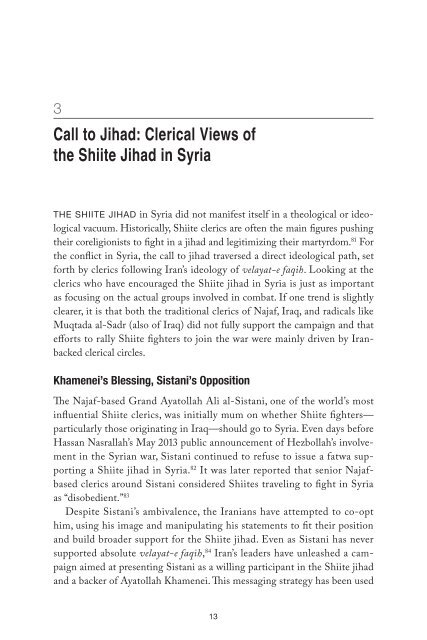You also want an ePaper? Increase the reach of your titles
YUMPU automatically turns print PDFs into web optimized ePapers that Google loves.
3<br />
Call to Jihad: Clerical Views of<br />
the Shiite Jihad in Syria<br />
<strong>THE</strong> <strong>SHIITE</strong> <strong>JIHAD</strong> in Syria did not manifest itself in a theological or ideological<br />
vacuum. Historically, Shiite clerics are often the main figures pushing<br />
their coreligionists to fight in a jihad and legitimizing their martyrdom. 81 For<br />
the conflict in Syria, the call to jihad traversed a direct ideological path, set<br />
forth by clerics following Iran’s ideology of velayat-e faqih. Looking at the<br />
clerics who have encouraged the Shiite jihad in Syria is just as important<br />
as focusing on the actual groups involved in combat. If one trend is slightly<br />
clearer, it is that both the traditional clerics of Najaf, Iraq, and radicals like<br />
Muqtada al-Sadr (also of Iraq) did not fully support the campaign and that<br />
efforts to rally Shiite fighters to join the war were mainly driven by Iranbacked<br />
clerical circles.<br />
Khamenei’s Blessing, Sistani’s Opposition<br />
The Najaf-based Grand Ayatollah Ali al-Sistani, one of the world’s most<br />
influential Shiite clerics, was initially mum on whether Shiite fighters—<br />
particularly those originating in Iraq—should go to Syria. Even days before<br />
Hassan Nasrallah’s May 2013 public announcement of Hezbollah’s involvement<br />
in the Syrian war, Sistani continued to refuse to issue a fatwa supporting<br />
a Shiite jihad in Syria. 82 It was later reported that senior Najafbased<br />
clerics around Sistani considered Shiites traveling to fight in Syria<br />
as “disobedient.” 83<br />
Despite Sistani’s ambivalence, the Iranians have attempted to co-opt<br />
him, using his image and manipulating his statements to fit their position<br />
and build broader support for the Shiite jihad. Even as Sistani has never<br />
supported absolute velayat-e faqih, 84 Iran’s leaders have unleashed a campaign<br />
aimed at presenting Sistani as a willing participant in the Shiite jihad<br />
and a backer of Ayatollah Khamenei. This messaging strategy has been used<br />
13


